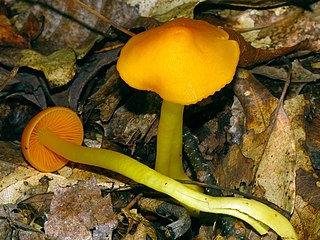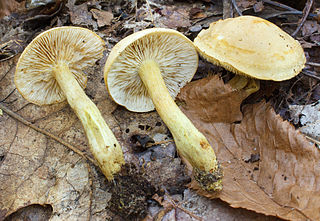
Tricholoma is a genus of fungus that contains many fairly fleshy white-spored gilled mushrooms which are found worldwide generally growing in woodlands. These are ectomycorrhizal fungi, existing in a symbiotic relationship with various species of coniferous or broad-leaved trees. The generic name derives from Ancient Greek: τριχο-, romanized: tricho-, lit. 'hair' and Ancient Greek: λῶμα, romanized: loma, lit. 'fringe, border' although only a few species have shaggy caps which fit this description.

Tricholoma equestre or Tricholoma flavovirens, commonly known as the man on horseback or yellow knight is a widely eaten but arguably toxic fungus of the genus Tricholoma that forms ectomycorrhiza with pine trees.

Tricholoma magnivelare, commonly known as the matsutake, white matsutake, ponderosa mushroom, pine mushroom, or American matsutake, is a gilled mushroom found East of the Rocky Mountains in North America growing in coniferous woodland. These ectomycorrhizal fungi are typically edible species that exist in a symbiotic relationship with various species of pine, commonly jack pine. They belong to the genus Tricholoma, which includes the closely related East Asian songi or matsutake as well as the Western matsutake and Meso-American matsutake.

Gymnopilus luteofolius, known as the yellow-gilled gymnopilus, is a large and widely distributed mushroom that grows in dense clusters on dead hardwoods and conifers. It grows in late July to November in the east and in the winter on the west coast of North America. It has a rusty orange spore print and a bitter taste.

Venturia is a genus of fungi in the family Venturiaceae. First identified in 1882, species in the genus are plant pathogens. Venturia is widespread and the genus contains an estimated 58 species, or 130 species. Anamorphs were historically represented in the genus Fusicladium.

Humidicutis marginata is a gilled fungus of the waxcap family.

Tricholoma davisiae is a mushroom of the agaric genus Tricholoma. It was first formally described by Charles Horton Peck in 1900.
Tricholoma farinaceum is a mushroom of the agaric genus Tricholoma.

Tricholoma intermedium is a mushroom of the agaric genus Tricholoma. It was formally described by American mycologist Charles Horton Peck in 1888.

Tricholoma niveipes is a mushroom of the agaric genus Tricholoma. It was formally described as new to science by American mycologist Charles Horton Peck in 1901.

Tricholoma odorum is a mushroom of the agaric genus Tricholoma. It was formally described in 1898 by American mycologist Charles Horton Peck. It is considered inedible.
Tricholoma acre is a mushroom of the agaric genus Tricholoma. The fruit bodies have light gray caps and stems, light grey gills, and an acrid taste.

Tricholoma subluteum is a mushroom of the agaric genus Tricholoma. Found in North America, it was described in 1904 by Charles Horton Peck.

Tricholoma subresplendens is a mushroom of the agaric genus Tricholoma. It was first described by American mycologist William Alphonso Murrill in 1914.

Mycena purpureofusca, commonly known as the purple edge bonnet, is a species of agaric fungus in the family Mycenaceae. First described by Charles Horton Peck in 1885, the species is found in Europe and North America, where it grows on the decaying wood and debris of conifers, including cones. Fruit bodies have conical to bell-shaped purple caps up to 2.5 cm (1 in) set atop slender stipes up to 10 cm (4 in) long. The mushroom is named for the characteristic dark greyish-purple color of its gill edges. In the field, M. purpureofusca mushrooms can usually be distinguished from similar species by characteristics such as the dark purple gill edges, the deep purple cap center, and its cartilagineous consistency. The fungus contains a laccase enzyme that has been investigated scientifically for its potential to detoxify recalcitrant industrial dyes used in textile dyeing and printing processes.

Tricholoma sejunctum is a mushroom that appears across much of the Northern Hemisphere and is associated with pine forests.

Mycena subcaerulea is a species of mushroom-forming fungus in the family Mycenaceae. It produces small, thin-fleshed fruitbodies with pale bluish-green caps upon slender stipes. The centers of the caps are darker in colour than the margins, and the cap cuticle can be peeled off. The fungus was first described in 1873 as Agaricus subcaeruleus by American mycologist Charles Horton Peck. His original collections, found growing on the trunks of decaying beech trees, were made in woods of the Adirondack Mountains in Upstate New York. Pier Andrea Saccardo transferred the species to the genus Mycena in 1887.

Geopyxis vulcanalis, commonly known as the vulcan pixie cup, is a species of cup fungus in the family Pyronemataceae. It was first described scientifically in 1878 by American mycologist Charles Horton Peck, from collections made in the Adirondack Mountains in Upstate New York. Pier Andrea Saccardo transferred it to the genus Geopyxis in 1889. Fruitbodies of G. vulcanalis are small and cup-like, with a light yellow hymenium. They become somewhat flattened in age. It grows on the ground in unburned conifer litter, often with mosses. Its spores are smooth and elliptical, measuring 14–21 by 8–11 µm.
















